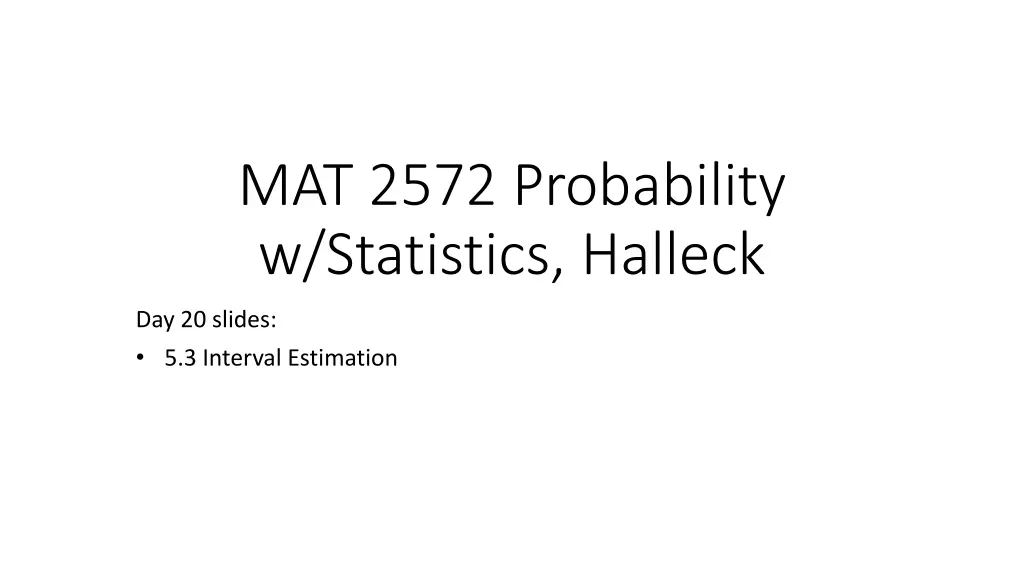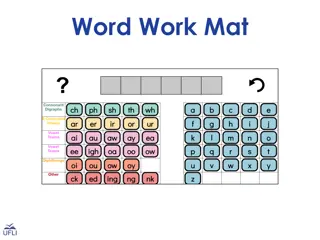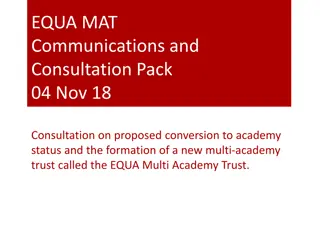
Understanding Interval Estimation in Probability with Statistics
Learn about interval estimation in probability with statistics, including the concept of confidence intervals, point estimates, and the role of normal distributions. Explore examples and calculations for better understanding.
Download Presentation

Please find below an Image/Link to download the presentation.
The content on the website is provided AS IS for your information and personal use only. It may not be sold, licensed, or shared on other websites without obtaining consent from the author. If you encounter any issues during the download, it is possible that the publisher has removed the file from their server.
You are allowed to download the files provided on this website for personal or commercial use, subject to the condition that they are used lawfully. All files are the property of their respective owners.
The content on the website is provided AS IS for your information and personal use only. It may not be sold, licensed, or shared on other websites without obtaining consent from the author.
E N D
Presentation Transcript
MAT 2572 Probability w/Statistics, Halleck Day 20 slides: 5.3 Interval Estimation
Point estimates Example: ?= ? is maximum likelihood estimator for Poisson parameter . weakness: provide no indication of their inherent precision If ? = 6 and ? = 6.8, does it follow that the true is close to ? say, in [6.7,6.9] or could be as small as 1.0, or as large as 12.0? Point estimates don t allow us to make such extrapolations. What is lacking: estimator s variation
Confidence interval is a range of numbers that have a high probability of containing the unknown parameter as an interior point. By looking at width of confidence interval, we get sense of estimator s precision. Typically, we like to have 95% certainty.
Normal distributions role Recall CLT: Normal distribution approximates the sampling from any distribution. Larger the sample size n, better the approximation. Even for distributions that are highly non-normal (e.g., uniform), by n=30, the sampling distribution will be normal for most intents and purposes. For the standard normal, the interval with radius 1.96 centered at 0, holds 95% of the outcomes:
Bent coin flip example with n=36 A coin is flipped 36 times and we get 12 heads. Provide a 95% confidence interval for this coin s chance of a head. Find experimental mean and standard deviation: 1 3 2 36= e= ? =12 Substitute into equation for Z : 1.96 ? 1.96 or 1.96 ??? e Solve for ???: 1.96 .0786 + .333 ??? 1.96 .0786 + .333 or .179 ??? .487 Conclude: with 95% certainty, the actual (as opposed to measured) chance of a head is in the interval [.18, .49]. 36=1 ?? ?= ?? ?= 1 2 3and ?= 3 162= 18= .0786 .08 1.96 or 1.96 ??? .333 1.96 .0786
Bent coin flip example (cont.) [.18 measured chance of a head .33 .49] actual chance of head
Possible 95% confidence intervals for We only went 6 for 8 or 75%, but unless our assumptions or measure- ments are wrong, we should in the long run bat at a 95% success rate.
Standard error and margin of error The standard error is ?= where n is the sample size is the standard deviation for the distribution being sampled The margin of error is width of 95% confidence interval (i.e., 1.96* ?). Roughly margin of error= 2 ? width of conf. interval = 2 margin of error ?
Bent coin flip example (revisited) [.18 Width of confidence interval is .49-.18=.31 Margin of error is ~.16 Standard error is ~.08. .33 .49]
Trumps Poll #s among NY republicans (Aug 2016) A poll is taken of 400 registered NY republican voters & 220 support Trump. http://www.businessinsider.com/donald-trump-new-york-poll-2016-8 a. Provide a confidence interval for his support then. b. Express the result as his most likely support margin of error e= ? =220 ?? ?= .55 .45 400 400= .55 and ?= 1.96 .025 + .55 ??? 1.96 .025 + .55 or .50 ??? .60 a. With 95% certainty, Trump s actual (as opposed to measured) support among NY republican voters was at least 50% but at most 60%. b. In other words, his support was 55% 5%. = .25
Clintons numbers in New Hampshire Clinton believed she had 53% support in New Hampshire. She wanted to have 95% certainty that she has 50 or more % support. Assuming that the numbers will hold up in a new poll, what sample size should be chosen to provide that certainty? z.95= 1.65 1.65 ?= .03 (see graph on next slide) ?? ?= .53 .47 ? .53 .47 ? e= .53 and ?= so = 1.65 = .03 and solving for n gives ? =1.652 .53 .47 = 753.5. .032 So she needed her poll size to be 754 (typically we round up)
Clintons numbers(cont.): graph for her support Chance that she is behind (want it to <5%) Chance that she is ahead (want it to be >95%) z.95= 1.65 .50 1.65 ? .53
finite correction factor Binomial Hypergeometric Since (N n)/(N 1) < 1, the Hypergeom var is smaller than binom var. The ratio (N n)/(N 1) is the finite correction factor (fcf). If N is much larger than n, then the fcf will be close to 1 and hence a binomial assumption is more than adequate. Only when sample is a sizeable fraction of population do we need to include the fcf in any calculations.
Finite correction factor example In a Maine village there are 300 voters. An exit poll is taken of 100. 55 indicate that they voted yes to allow sale of marijuana in their village. 45 said that they voted no. Find a 95% confidence interval representing support for the measure. Since sample size (100) is substantial portion of population size (300), we ? ? ? 1= 300 100 300 1= 200 299= .818 calculate finite correction factor: ?? ?= .55 .45 100 = .0497 so w/ fcf, we get ?=.0407 Without the fcf, the So C.I. is 1.96 .0407 + .55 ??? 1.96 .0407 + .55 or [.47,.63] In spite of the exit poll indicating otherwise, there is still a good chance that the measure did not pass.
Exercise 5.3.14 If (0.57, 0.63) is a 50% confidence interval for p, what is the estimate for p and how many observations were taken? ??= .6 and z.25=.674 ?? ?= .6 .4 ? so .674 .6 .4 ? ?= = .03 and solving for n gives ? =.6742 .6 .4 = 121.1. .032 But here we don t need to round up, just to nearest integer, so n=121






















